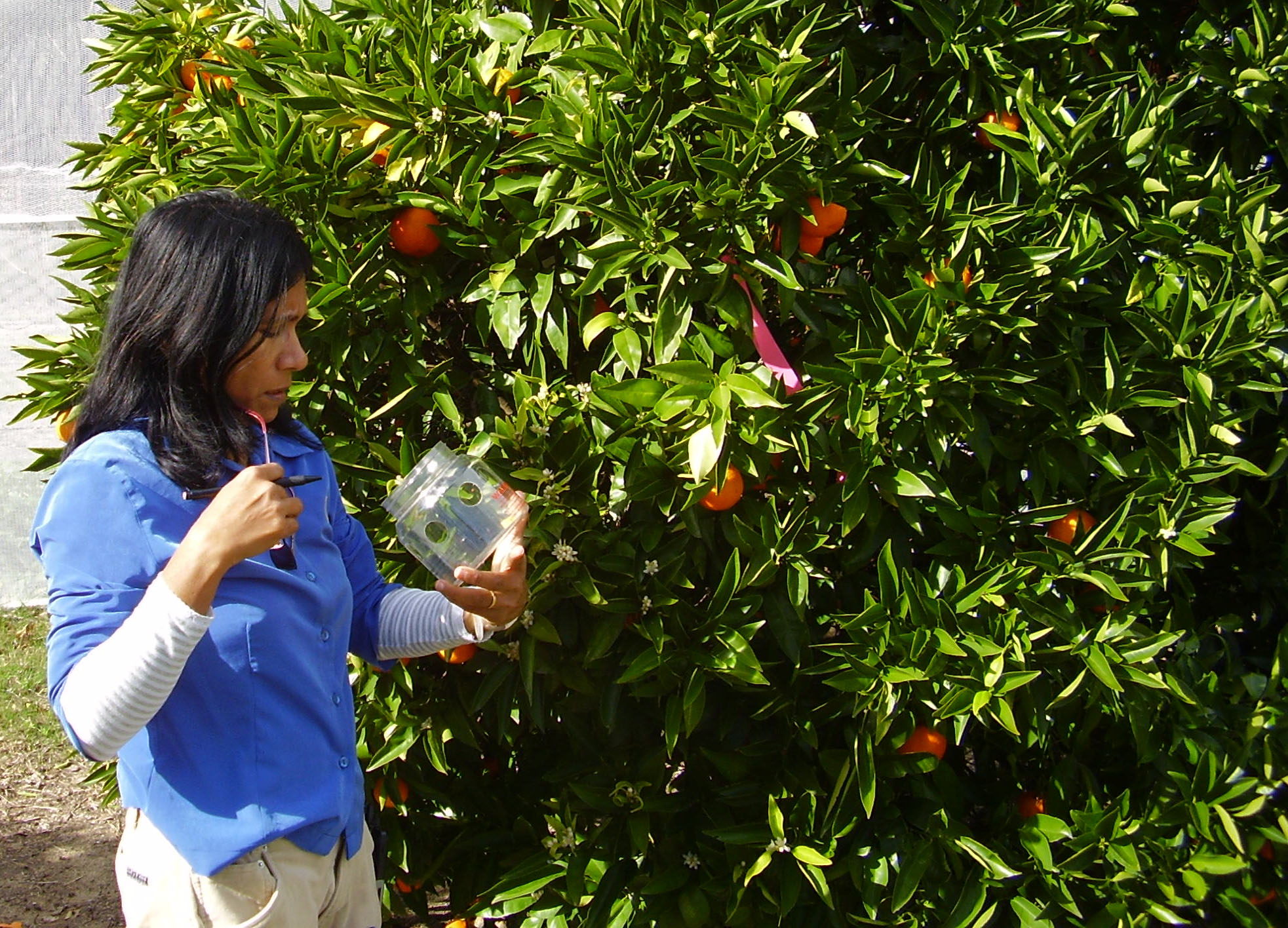monitoring
Strong resistance to phosphine in the rusty grain beetle, Cryptolestes ferrugineus (Stephens) (Coleoptera: Laemophloeidae): its characterisation, a rapid assay for diagnosis and its distribution in Australia
| Publication Type | Journal Article | |
| Year of Publication | 2012 | |
| Authors | Nayak, M.; Holloway, J.; Emery, R.; Pavic, H.; Bartleta, J.; Collins, P. | |
| Journal Title | Pest Management Science |
Lessons learned from phosphine resistance monitoring in Australia
| Publication Type | Journal Article | |
| Year of Publication | 2011 | |
| Authors | Emery, R.; Nayak, M.; Holloway, J. | |
| Journal Title | Stewart Postharvest Review | |
| Pages | 8 |
Female fruit fly lures improve orchard pest protection
 A new tool is being tested in Western Australia to improve monitoring for a range
A new tool is being tested in Western Australia to improve monitoring for a range
The aim of this project is to develop a rapid and customised (for Australia) internet web crawler which will detect organisations who would intend to market via the internet, regulated organisms and commodities (invasive species) which are prohibited entry to Australia owing to the threat they present to Australian plant health generally, and specifically, those organisms which would threaten Australia's plant-based industries.
What is the biosecurity problem?
Worldwide the risk of pests crossing national borders (pest pressure) is becoming evermore acute as volumes of trade and the movement of goods continue to increase. The purpose of conducting this project is to augment existing border quarantine mechanisms by way of addressing the specific risk area presented by internet sales of commodities which may threaten plant health in Australia. As normal pathways for the movement of goods across borders have increased, so too have internet sales. Internet sales represent a special challenge for border quarantine regulators because the movement of the risk goods involved (plants, seeds, plant parts) is often via mail or parcel delivery by private mail contractors which are difficult to monitor for quarantine purposes.
The main outputs of this project are to:
- Develop applicable local search terms in consultation with local subject matter experts
- Create/generate initial search data with includer/excluder terms
- Conduct an Internet search/crawl
- Creation of end-user interface
- Evaluation of a filtered list relevance and refinement of includer/excluder terms
Who will be the end-users of this research?
All sectors of the Australian biosecurity community - federal, state and industry - in plants, animals and natural resources.
PROJECT LEADER

Mr Robert Emery
Project Leader CRC30062: AIMS
remery@agric.wa.gov.au
Phone: 08 9368 3247
Fax: 08 9368 3223
Read More
PROJECT DETAILS
Complete
Term
April 2008 - December 2008
PROGRAM DETAILS
LOCATION
CORE CRC PARTICIPANTS
This project will enhance the capacity of Australia's plant industries to respond to future EPP incursions by providing comprehensive and relevant ‘real time' terrestrial data.
What is the biosecurity problem?
Despite Australia having one of the most advanced biosecurity programs in the world, it has some weaknesses in its analytical capacity to assess the most effective responses (alternative strategies) to EPP incursions and their associated economic costs either proactively or during an eradication response. In order to effectively validate/evaluate contingency plans that would be utilised in response to an EPP incursion, it is important that a detailed source of relevant terrestrial data is available for the predictive simulation system.
At present, a limited amount of historical data can be sourced but there is no capacity to provide ‘real time' data that includes all relevant factors. The NASA Terrestrial Observation System (TOPS) program has the potential to greatly enhance the capacity of Australia's plant industries to respond to future EPP incursions by providing this data source.
The main outputs of this project are to:
- train an Australian Postgraduate (PhD) candidate in GIS and ecosystem and socio-economic modelling to contribute to the validation and evaluation of contingency plans
- evaluate the NASA Terrestrial Observation System (TOPS) for use in incursion management in Australia, and
- identify opportunities for additional funding through NASA and other US funding sources, with a particular focus on enhancing international collaboration.
Who will be the end-users of this research?
This project will deliver a new PhD graduate trained in the use of GIS technologies, ecological modelling, and simulation and assessment of EPP incursions. The graduate will be available for immediate employment within the biosecurity industry, increasing Australia's capability to predict and respond to emergency plant pests using advanced technologies. If the NASA TOPS program is validated as being a useful monitoring system, this may also provide wider industry benefits that may have some commercial application.
STUDENT

Mr John Weiss
Student CRC60008: Terrestrial Observation Predictive Systems - PhD
john.weiss@dpi.vic.gov.au
Phone: 03 9785 0111
Fax: 03 9785 2007
Read More
PROJECT DETAILS
Active
Supervisor
Dr Simon McKirdy, CRCNPB and Dr Mick McCarthy, University of Melbourne
Supervising Institution
University of Melbourne
Term
April 2007- April 2011
LOCATION
This project will develop tools for plant pathogen recognition to support rapid response to disease threats.
What is the biosecurity problem?
The development of tools for pathogen recognition enabling rapid response has been listed as one of the top issues to improve Australia's preparedness to deal with emerging disease threats.
The main outputs of this project are to:
- develop methodology for DNA detection of airborne pathogens from spore traps using known model systems.
- develop methodology for monitoring exotic and unknown pathogens in spore traps (using community analysis DNA methods such as T-RFLP).
- develop and evaluate alternative eradication strategies for high priority emergency plant pests affecting industries based on perennial species.
Who will be the end-users of this research?
This project will deliver a new PhD graduate trained in plant pathology with specific skills in pathogen detection and monitoring. The graduate will be available for employment within the Australian plant biosecurity system, enhancing Australia's capacity for pathogen recognition and enabling rapid responses to emergency plant pests.
STUDENT

Ms Bonny Vogelzang
Student CRC60017: Detection in Pathogen Mixtures - PhD
vogelzang.bonny@sa.gov.au
Phone: 08 8303 9390
Fax: 08 8303 9393
Read More
PROJECT DETAILS
Complete
Supervisor
Dr Jenny Davidson , SARDI
Supervising Institution
University of Adelaide
Term
July 2006 - June 2009
LOCATION
The main goal of this project was to undertake research that will develop technically sound sample/survey methodologies and systems to enhance the ability to capture a wide range of plant health information in an accurate and cost-effective manner both domestically and internationally.
What is the biosecurity problem?
I aimed to create the necessary tools to significantly reduce the amount of human intervention, as required in present systems. The computational techniques will be required to recognise and identified EPPs in real-time on-board automatic insect traps. The use of imaging technologies based upon hyperspectral and UV ranges to develop a statistical and computational framework for the classification and identification of selected EPPs are challenges.
The main outputs of this project were to:
- devlop new, better understanding of shape/image descriptors suitable for spectral imagery specially designed for biosecurity surveillance systems
- create a set of kernel-based, statistical methods that can be used to perform classification of emergency plant pests making use of the descriptors developed in item 1, and
- develop a framework that will permit the extension of the classification methods developed in item 2 to include domain knowledge. This will involve the development of semi-supervised pattern recognition and interactive computer vision methods based upon statistics that are scalable and capable of real-time analysis.
Who are the end-users of this research?
Automatic and continuous monitoring capabilities of ‘smart traps' have a high potential for commercialisation, both nationally and internationally. Such technology will most likely be adopted by state agencies and plant-based industries involved in early warning networks for emergency plant pests to increase efficiency and reduce cost of monitoring early warning insect traps. Outcomes from this project may also be applicable to a range of biosecurity issues such as semi-automated surveillance systems in quarantine facilities, index databases, building of libraries for future reference, etc.
STUDENT
PROJECT DETAILS
Complete
Supervisor
Dr Antonio Robles-Kelly and Dr Jun Zhou (ANU) and Dr Louise Morin (CSIRO Entomology)
Supervising Institution
Australian National University
Term
March 2008 – March 2011


